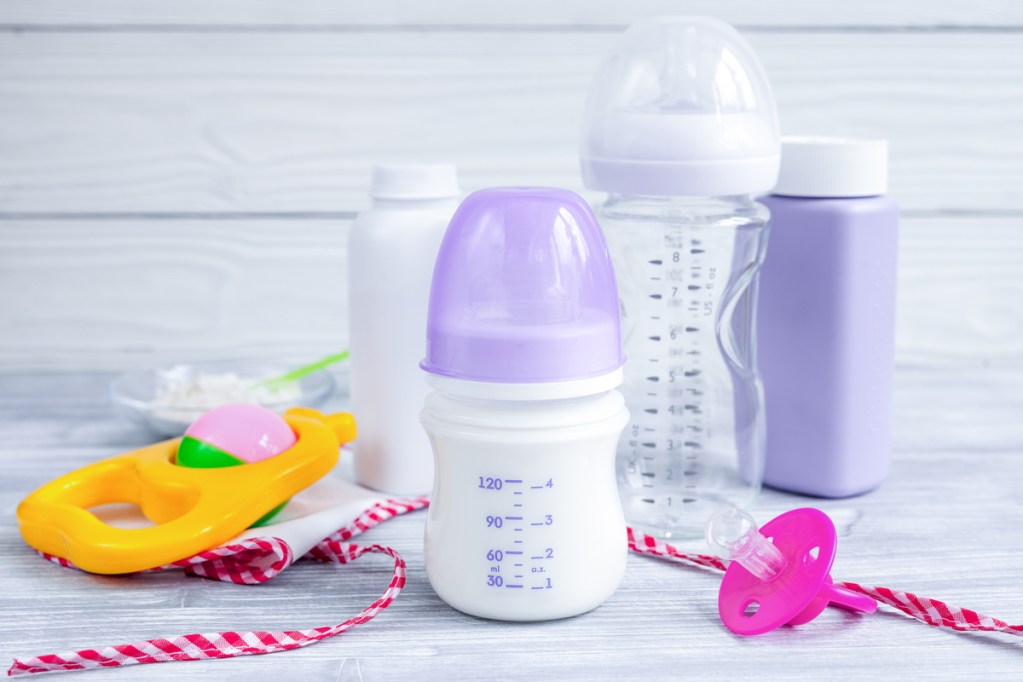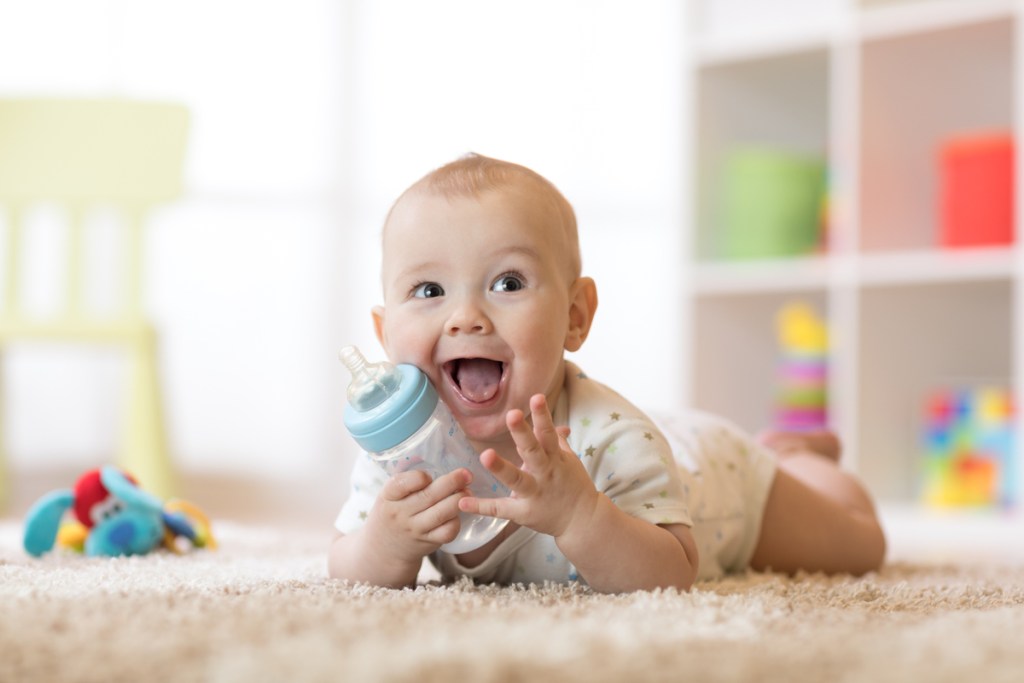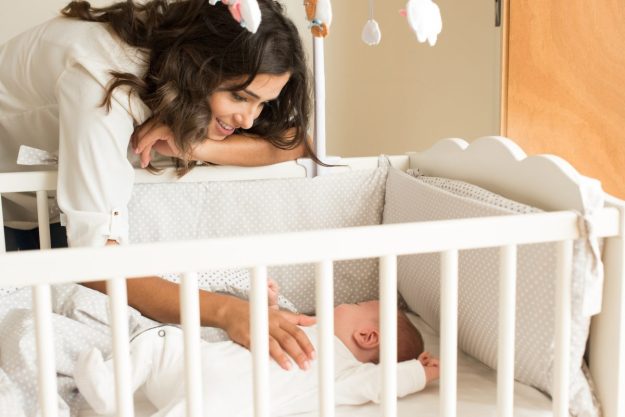
Your sweet little milk chugger goes through bottles like they’re going out of style. And those dirty glass and plastic vessels pile up in the kitchen sink every day and every night. Life with an infant — it sure is glamorous, isn’t it? Sanitizing bottles. Cleaning pacifiers. You will want to tackle that dirty load sooner than later; the last thing you want to be doing at 3 a.m. is scrubbing the inside of a dirty bottle so your baby can eat. What’s more, keeping your baby’s bottles and pacifiers clean will help ensure your little one won’t get sick from hidden germs or bacteria. Whether you are a first-time parent or just haven’t had a new baby in the house for a bit, here’s how to sanitize pacifiers, bottles, and nipples so your baby stays healthy and fed.

When you need to sterilize the goods
No, you do not need to sterilize a bottle between every use, nor do you need to perpetually pop your baby’s beloved pacifier in a boiling pot of water. Regular washing and rinsing should suffice, however, there are some circumstances that warrant a thorough sterilizing process.
How to keep everything clean
- If your baby is born prematurely or has a weakened immune system, you should sterilize bottles before use, as recommended by the Centers for Disease Control and Prevention (CDC). Some doctors also recommend sterilizing bottles for babies up to 3 months of age.
- A baby’s immune system is a bit stronger at around 3 months, so if you have been regularly sanitizing bottles and pacifiers, consider stopping at this point. When in doubt, talk to your child’s pediatrician for further guidance.
- You should sterilize bottles and pacifiers before you give them to your baby for the first time to ensure they are completely clean and germ-free. This is especially pertinent if you are using old ones from a previous baby or secondhand options. Be sure any hand-me-down bottles or pacifiers are free of BPA.
- Sterilize Baby’s bottles or pacifiers after an illness to eradicate any lurking bacteria or germs.
- If you use well water or do not have access to clean, fresh water, you should sterilize bottles and pacifiers between uses.

The best ways to sterilize pacifiers, bottles, and bottle parts
Boil those bottles and pacifiers
There’s a low-tech but highly effective method of cleaning pacifiers and sanitizing bottles — boil them in water.
- First, wash bottles regularly with dish soap and water and rinse pacifiers.
- Add all your bottles, bottle parts, nipples, and pacifiers into a large pot.
- Add water, making sure that everything is fully submerged.
- Turn on the stove and bring the water to a boil.
- Keep the bottles in the boiling water for approximately five minutes.
- Carefully remove them.
- Place bottles upside down on a rack or clean cloth; leave everything out to air-dry.
Try a microwave sterilizer
A microwave bottle steam sterilizer is a great and affordable option for easily and efficiently cleaning bottles and pacifiers. It encloses bottle parts and traps steam to fully sanitize everything.
- Fill bottles halfway with water.
- Put them in your system.
- Put the unit in a clean microwave (sorry to say, you can’t skip this step).
- Microwave on a high setting for about a minute and a half.
- Remove (they will be hot — so use caution), pour out any remaining water, and dry.
Use an electric steam sanitizer
If you plan on sanitizing bottles frequently, an electric steam sanitizer will come in handy. Simply place bottles inside and follow the model’s instructions. The temperature of the steam produced is higher than that of boiling water, so this is a super-effective, quick, and convenient option. Most steam sterilizers complete a cycle within a few minutes — easy-breezy.
Put them in the dishwasher
Don’t want to spend hours scrubbing your bottles by hand? Run them in the dishwasher if you have one. While you should always check manufacturer instructions, most bottles can be cleaned on the hottest washing and drying cycles, which is pretty much akin to sterilizing.
Sterilize with a bleach solution as a backup method
Believe it or not, you can sanitize bottles and pacifiers with cold water by using a specific sanitizing tablet or solution. As advised by the CDC, if you are unable to steam with heat (the preferable methods listed), soak items in two teaspoons of unscented bleach diluted in one gallon of water for about two minutes or more.
Intuitively, you will want to rinse afterward, but this actually reintroduces germs. Instead, let items air-dry. Again, this is an alternative method to use as needed, but if you have access to a dishwasher, boiling water, or a steam-sanitizing system, skip this altogether.

Keep these sterilizing tips in mind
Thinking about the five-second rule when that pacifier falls out of the baby’s mouth is a given for any parent. And while sanitizing after every feeding would be near impossible — and it’s not even going to happen on little to no sleep anyway — your baby’s feeding supplies shouldn’t go an extended period of time without a deep clean.
Water alone is not enough
Giving it a little rinsy rinse under tap water might cut it for some vegetables from time to time, but that should not be the way you clean bottles and other things your child will have in their mouth. A dropped pacifier for two seconds at the park rinsed with your bottled water is different than the cleanliness of the same bottle your baby has been using all week. You need to use elbow grease and clean those pieces every day with water, soap, and a cleaning item like a sponge or brush.
Don’t skip the deep sterilizing
Just don’t skip it. You want that healthy baby to stay happy and fed, and a gross, dirty bottle or pacifier will only lead to everyone crying. When your baby is a newborn to six months old, wash the items after every use, and sterilize once a day. Once your little one is six months old, if you wash the items every day, you could properly sterilize a few times a week to once a week if they aren’t in places like a daycare where we all know extra germs and bacteria are unavoidable.
Don’t forget to really look at the condition of the items
Depending on what material the bottles, nipples, and pacifiers are made of, and what quality, deep sterilizing will take its toll. Always check the nipples for larger holes or tears that could lead to your baby choking. But don’t not sanitize because this could happen. Regular sanitation wears on bottles, nipples, and pacifiers, so inspect these items often and discontinue use if and when their integrity is compromised.
Washing bottles is part of the parenting gig. You’ll have to scrub between uses regardless of whether you decide to sanitize them regularly or not. While a steam sanitizer — either a microwave or electric option — makes this process a little easier, you could also choose to boil them or just place them in your standard dishwasher top rack.
Baby’s health is of the utmost importance, and having clean pacifiers and bottles at the ready will streamline this chore. You will be thankful you did your sanitizing due diligence when you can just pop that binky or nipple in your babe’s mouth without worry. You’ll also be a pro when it comes time for all of those sippy cups during the toddler years.
Editors' Recommendations
- When do babies start talking? Should you be concerned if yours isn’t?
- Why do babies growl? Understanding your little one’s weird sounds
- Is your kid screaming for no reason? Here are ways to deal with a screaming child’s behavior
- How long is formula good for? This is when to toss it
- We love these gorgeous aesthetic names for baby boys and girls


